Physical Address
304 North Cardinal St.
Dorchester Center, MA 02124
Musculoskeletal infections remain a diagnostic and therapeutic challenge. Historically, the workup and treatment of such infections has been based on clinical grounds supplemented by diagnostic aspiration and subsequent surgical incision and drainage. Today, imaging plays a critical role in the diagnosis and management of musculoskeletal infections.
This chapter will review the clinical presentation, pathophysiology, imaging, and treatment spectrum of osteomyelitis, septic arthritis, and soft tissue infections of the appendicular skeleton.
Osteomyelitis may occur from direct or hematogenous inoculation; it may be iatrogenic, related to orthopedic implants; or it may be from secondary extension from primary septic arthritis or pyomyositis. Hematogenous osteomyelitis is a common disease in children; however, infantile and even neonatal cases are not uncommon. Bacteria are the most common inflammatory agents, but growing bones may also be invaded by other pathogens, including viruses, spirochetes, and fungi.
The incidence of pediatric osteomyelitis in the United States is 1 in 5150 and has increased 2.8-fold in 20 years. This increased incidence is confounded, however, because of differences in access to health care and advances in imaging diagnosis. Staphylococcus aureus remains the most common causative organism of acute osteomyelitis in children. Unfortunately, community-acquired methicillin-resistant S. aureus (MRSA) strains are increasing in prevalence. Haemophilus influenzae osteomyelitis and septic arthritis have become less common since the availability of effective vaccination ( H. influenzae type B vaccine).
In sickle cell disease, bone complications include osteonecrosis and osteomyelitis. Osteonecrosis is approximately 50 times more frequent than osteomyelitis. The proposed mechanism of osteomyelitis is hematogenous, with bacteria gaining entrance to blood vessels through ischemic bowel and finding suitable culture material in foci of infarcted bone marrow. Both S. aureus and Salmonella commonly occur in sickle cell patients.
In chronic granulomatous disease of childhood, an X-linked recessive disorder of leukocyte function, repeated infections occur in solid organs, skin, and bone. Approximately one-third of patients develop osteomyelitis. Phagocytes are unable to kill catalase-positive organisms such as Staphylococcus and fungi .
Hematogenous osteomyelitis usually involves the highly vascularized metaphysis of the fastest growing bones, such as the distal femur and radius and the proximal tibia and humerus. The most common location for hematogenous osteomyelitis is about the knee (distal femur, proximal tibia). Pain, localized signs, fever, reduced range of motion, and reduced weight bearing are the most common initial clinical features. A history of trauma is seen in approximately 30% of cases, and the male-to-female ratio is approximately 1 : 8.
Organisms lodge most frequently in the terminal capillary sinusoids of the metaphyses ( Fig. 137.1 ). Rarely, they may locate initially in the epiphyses related to the terminal capillary sinusoids of the metaphyseal equivalent region immediately next to the spherical growth plate. A small abscess forms in the marrow of the metaphysis, followed by local decalcification and destruction of the adjacent bone. When focal abscesses are generated, multiple small foci of bone destruction develop and later coalesce. Inflammatory swelling increases the intraosseous pressure because of the rigid bony walls of the marrow cavity; this can force extension of the infected exudate into several sites, as indicated in Fig. 137.2 . The most common route is via the haversian canals of the cortex to the subperiosteal space, where a subperiosteal abscess is formed. Simultaneously, spread also occurs farther within the medullary cavity. Rupture of the periosteal abscess is responsible for extension of infection into the adjacent soft tissues. Inflammation and rapidly increased intraosseous pressure may cause thrombosis of the vascular channels.
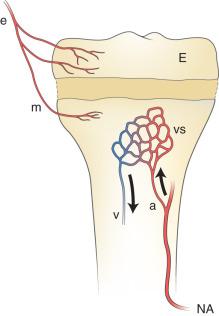
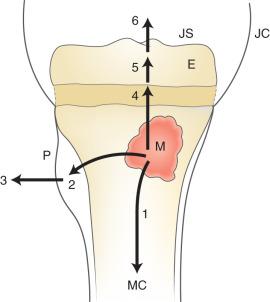
The most common location for direct inoculation osteomyelitis is the foot. Plantar puncture wounds secondary to walking on broken glass, metal (nail), or vegetable matter (thorn, toothpick) may result in infectious cellulitis, plantar fasciitis, and osteomyelitis, whether the foreign body is removed or retained. The calcaneus is often involved, and Pseudomonas aeruginosa is often found related to direct inoculation, usually with a history of a puncture through a shoe.
Imaging guidelines for the evaluation of suspected osteomyelitis include radiographs first to exclude alternative etiologies, such as a fracture or neoplasm, as an explanation for symptoms. If radiographs are normal and symptoms are localized to an osteoarticular region, ultrasound (US) may be performed to evaluate for suspected septic arthritis. Targeted magnetic resonance imaging (MRI) of the affected region should be performed to identify underlying osteomyelitis and to guide surgical treatment. Both MRI and US can also identify subperiosteal and soft tissue abscesses. When symptoms are not localizable a whole body MRI can be performed. Three-phase bone scintigraphy is recommended when symptoms are nonlocalizable and there are relative contraindications to MRI such as the need for sedation.
With acute osteomyelitis, the earliest change on radiographs is soft tissue swelling; osseous changes are seldom present until the second week of disease ( Fig. 137.3 ). The earliest bone changes seen on conventional images are one or more small radiolucencies, usually in the metaphyseal region, where necrosis and destruction of bone has occurred ( Fig. 137.4 ). On serial examinations, these areas of bone destruction enlarge and become confluent.
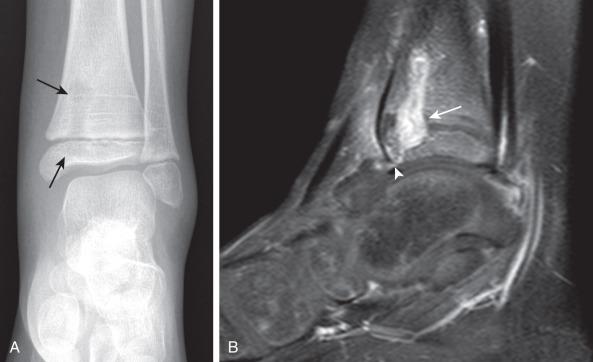
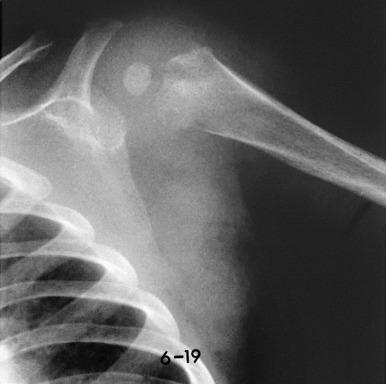
With continuing appropriate antibiotic therapy, periostitis is visible when the periosteum begins to produce new bone on its undersurface after the second or third week ( Fig. 137.5 ). Osteogenic function by the periosteum suggests that infection has been at least partly locally controlled. Subsequent healing may involve remodeling of the cortical new bone and reconstitution of the underlying bone or, if damage has been extensive, it may involve an increase in the amount of periosteal reaction to form an involucrum ( Fig. 137.6 ), a living bone sheath around the fragments of the old devitalized bone (sequestrum).
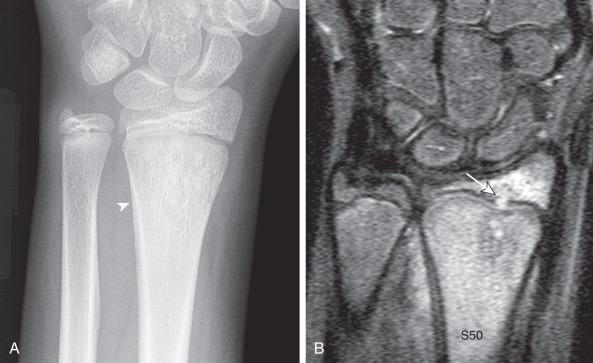
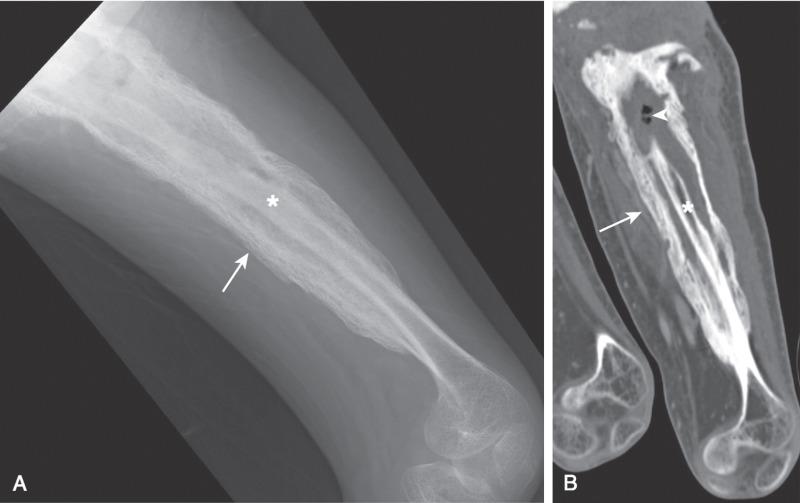
Bone scans are particularly helpful in the evaluation of suspected osteomyelitis when symptoms are not localizable due to its ability to scan the entire skeleton. Early bone scans may demonstrate a “cold” metaphyseal lesion as a result of compression or occlusion of the metaphyseal vessels. In these cases, increased activity is observed toward the diaphysis, beyond the cold metaphyseal area, which subsequently becomes “hot” and merges with the adjacent increased activity ( Fig. 137.7 ). The multiphase bone scan is very sensitive and is usually positive 24 to 48 hours after the onset of symptoms. It can detect extension of metaphyseal osteomyelitis into the epiphysis through the growth plate (see Fig. 137.7 ).
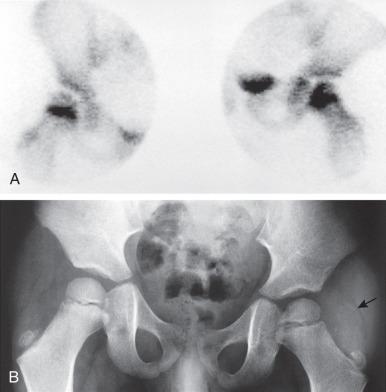
Another application of nuclear medicine imaging of musculoskeletal infections is to evaluate for infection in the setting of orthopedic hardware. In this situation, MRI may be of limited value due to susceptibility artifact. A normal bone scan can rule out infection. However, increased activity on a bone scan in this situation may be due to infection or hardware loosening. If this occurs, then a radiolabeled leukocyte scintigraphy scan (white blood cell scan) can be performed in conjunction with a Tc-99m sulfur colloid scan. Areas of increased radiotracer uptake on the leukocyte scan that are normal on the sulfur colloid scan are consistent with infection.
Computed tomography (CT) is of limited clinical value in acute osteomyelitis. It is more useful in advanced or chronic disease to help determine the quality of bone stock, including determinations of cortical destruction, involucrum, and sequestra (see Fig. 137.6 ).
MRI is the optimal study to evaluate for infection and alternative etiologies for symptoms, particularly when radiographs are normal. When precontrast MRI examinations are entirely normal and show no evidence to suggest osteomyelitis, routine postgadolinium images may not be necessary. When abnormal, MRI can reveal marrow alterations and extent of disease in bone, soft tissues, or adjacent joints ( Fig. 137.8 ). Early MRI findings of osteomyelitis may have a tumefactive appearance and may be paradoxically hypointense on fluid-sensitive sequences ( e-Fig. 137.9 ). Over time, the lesion may remain masslike and demonstrates the expected, more homogeneous hyperintense signal on fluid-sensitive sequences, indicative of its inflammatory nature ( Fig. 137.10 ). Eventually, periostitis and adjacent soft tissue involvement may be seen in the early phase of osteomyelitis ( e-Fig. 137.11 ). Subperiosteal abscess formation may be seen by sonography ( Fig. 137.12 ) or MRI ( Fig. 137.13 ), preceding radiographic bony changes. A salt-and-pepper appearance to the marrow may be seen in the late acute phase of osteomyelitis and is presumed to represent small areas of noncoalescent microabscess formation and early bone destruction ( Fig. 137.14 ). It is difficult to distinguish acute osteonecrosis from osteomyelitis in the setting of sickle cell disease on MRI ( Fig. 137.15 ).
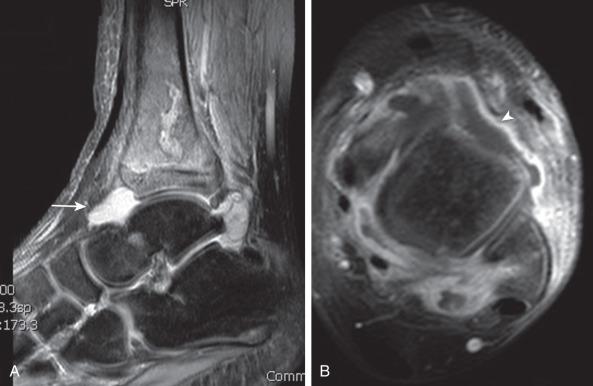
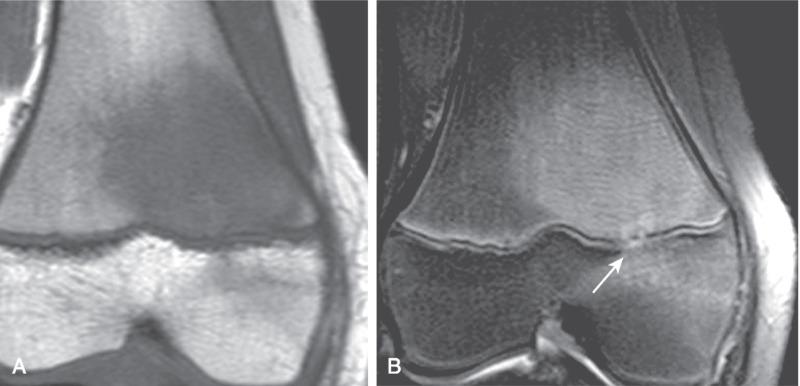
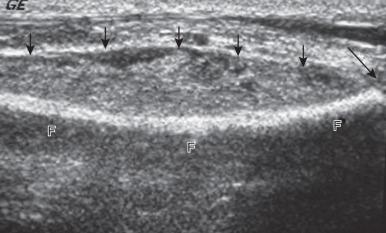
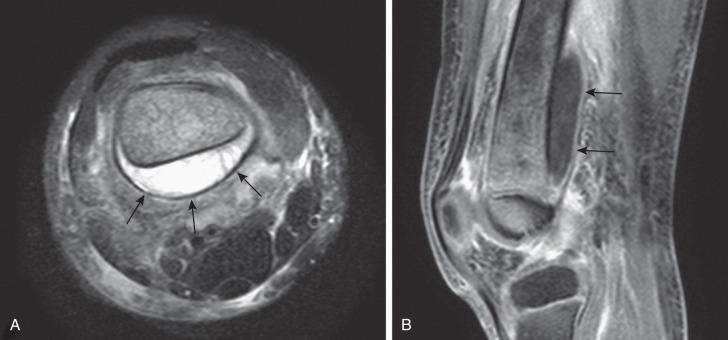

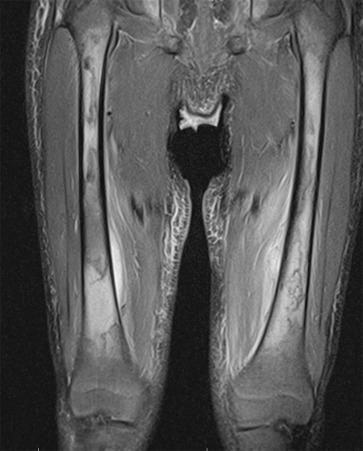
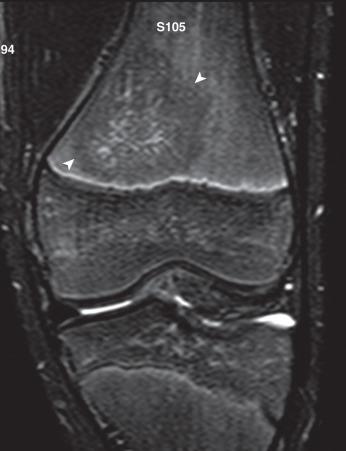
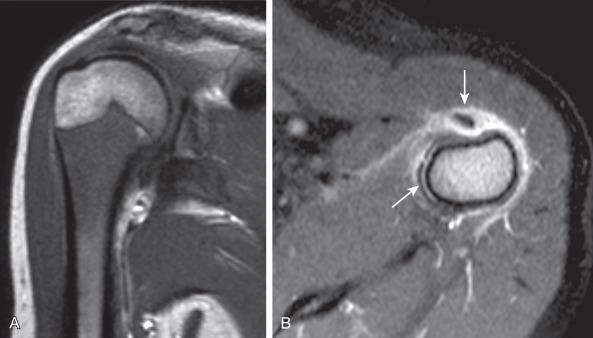
Musculoskeletal infections typically have localizable symptoms to the area of involvement allowing performance of a focal MRI. However, these infections may present as fever without a source or fever of unknown origin, particularly in very young children or developmentally disabled children who are not able to verbalize symptoms. One of the applications of whole body MRI is to evaluate for a nonlocalizable infection. Large field of view fluid-sensitive sequences, typically a short-tau inversion recovery (STIR) sequence, are typical of whole body protocols with the use of T1-weighted and diffusion sequences being used at some institutions. These allow for detection and localization of osteomyelitis ( Fig. 137.16 ) and other musculoskeletal infections (e.g., septic arthritis, infectious myositis, cellulitis, and periosteal and soft tissue abscesses).

Subacute or chronic osteomyelitis may develop as a result of partial host response to contain the infection. Distinguishing between subacute and chronic osteomyelitis is arbitrary. The initial purulent exudate is replaced by granulation tissue, and the clinical manifestations are mild and consist mainly of local pain. A Brodie abscess may then develop, typically in the metaphysis and less commonly in the epiphysis, because the growth plate is only a partial barrier against the spread of infection. A Brodie abscess is characterized radiographically by a central or eccentric round or oval radiolucency. The cavity may contain a small, dense sequestrum. On MRI, lesions have a characteristic layered appearance with a high-signal periphery as a result of edema (penumbra sign) and a double-line sign (rim sign), which on fluid-sensitive sequences is delineated as a low-signal outer rim because of sclerosis; an inner rim of intermediate signal because of granulation tissue; and a central, hyperintense region related to abscess formation ( Fig. 137.17 ). With contrast-enhanced imaging, the inner granulation layer will show enhancement around the nonenhancing central abscess.
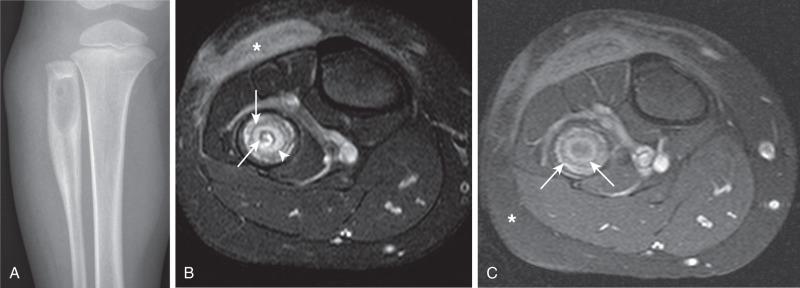
Adjacent soft tissue swelling and edema and periosteal new bone formation may be present. In spite of occasional growth plate involvement, the incidence of premature growth plate fusion after subacute osteomyelitis is rare.
Cortical and trabecular bone sclerosis, cavities, involucra, and sequestra are characteristic of advanced osteomyelitis. The affected bone is thickened, and its outline may be wavy, with or without periosteal cloaking of new bone. An involucrum of reactive, viable bone may cloak an area of infection ( Fig. 137.18 ). The involucrum may be perforated by a cloaca, which is a tract or communication between bone and the surrounding soft tissues ( e-Fig. 137.19 ). If the cloaca extends to the skin surface, it is termed a sinus tract (see Fig. 137.18 ). The necrotic, devitalized bone of a sequestrum is surrounded by inflammatory granulation tissue and may be located within a bone abscess cavity. The dead bone of a sequestrum is relatively sclerotic. Sequestra may be demonstrated on radiography, CT, or MRI, but it is best seen with CT (see Figs. 137.6 and 137.18 ). Sequestration is now relatively rare owing to earlier diagnosis, largely because of advances in imaging and more effective antibiotic therapies.

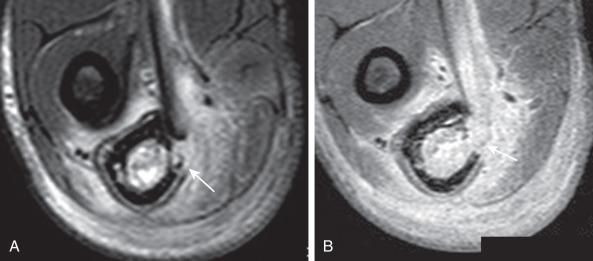
Radiographs will suggest the diagnosis of subacute or chronic osteomyelitis and may be used to follow up for gross changes. Although CT is of limited clinical value in acute osteomyelitis, it is very useful in imaging chronic disease to evaluate bone stock quality and to detect cortical metaphyseal tracts and channels, sequestra, and bone destruction. Serial MRI after an established diagnosis of osteomyelitis has been made, and after medical or surgical treatment, has limited utility but can be useful in patients who do not respond to therapy or who have a persistently elevated C-reactive protein level.
Not all marrow edema and granulation tissue identified on MRI represents a diagnosis of osteomyelitis; therefore a combination of imaging features and clinical history should be used in concert to arrive at such a diagnosis. Stress reaction may superficially mimic early osteomyelitis, and Ewing sarcoma may superficially mimic subacute or chronic osteomyelitis, with the mass related to Ewing sarcoma mimicking granulation tissue.
Although the mortality and morbidity of bone infection have decreased significantly, permanent sequelae do occur, largely as a result of delay in diagnosis or inadequate treatment with complications related to generalized bacterial sepsis. Complications of bone infection include pathologic fracture through regions of bone destruction, venous thrombosis, premature physeal closure, and adjacent infectious arthritis and destruction of joints ( Fig. 137.20 ).
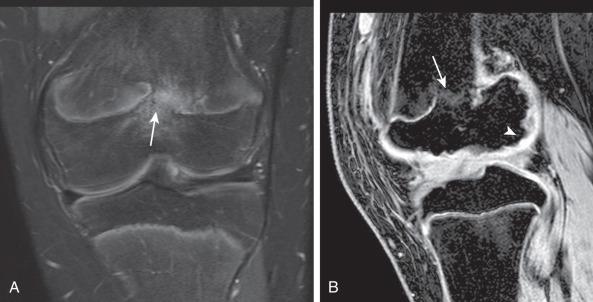
Identification of a bacterial pathogen for underlying osteomyelitis ranges from 9% to 22% by blood culture and 40% to 50% by bone or joint aspiration. MRI is useful for confirming or excluding the diagnosis of osteomyelitis, identifying fluid for culture, and preoperative planning for incision and drainage of potential intraosseous and extraosseous abscesses.
To decrease the chance of complications, empiric antibiotic therapy is often initiated even before bacterial culture is isolated. Treatment includes parenteral antibiotics followed by a long course of oral antibiotics, provided the child is not immunocompromised.
Surgical drainage is recommended if the child has not responded to antibiotics after 48 to 72 hours or if a substantial abscess is identified by MRI. If adjacent septic arthritis is present, the joint will need to be debrided as well.
In the young infants, the incidence of epiphyseal and joint involvement is higher ( Fig. 137.21 ), and multifocal disease may be seen. This is because of the persistence of metaphyseal vessels that cross the physis and extend into the intraarticularly located epiphysis. The most common causative organism is S. aureus. Other isolated organisms include Escherichia coli, group B streptococci, gram-negative rods, and Candida albicans. The hip is frequently involved, and neonatal calcaneal osteomyelitis may develop after heel pad puncture for blood drawing.
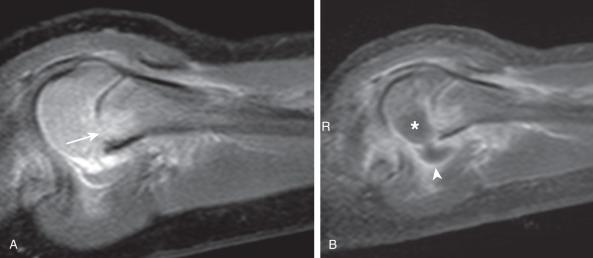
Become a Clinical Tree membership for Full access and enjoy Unlimited articles
If you are a member. Log in here